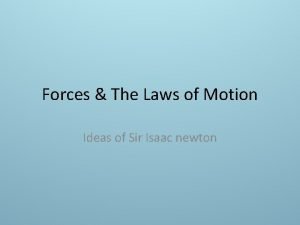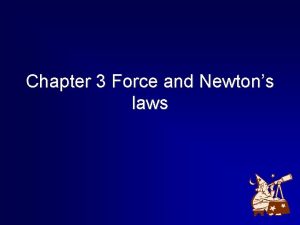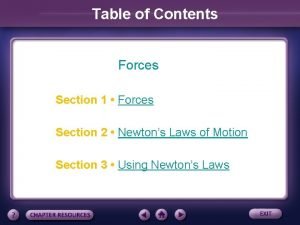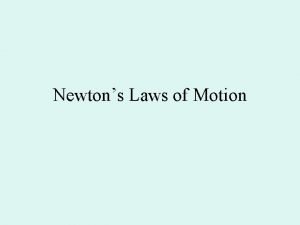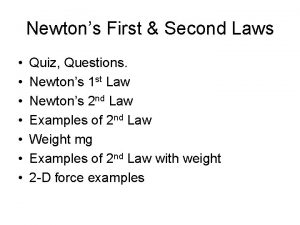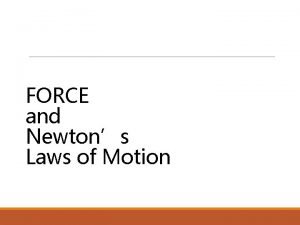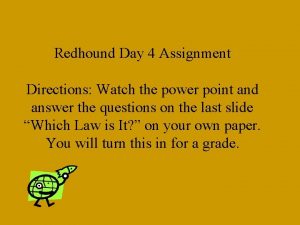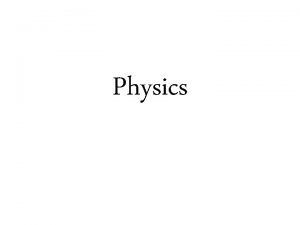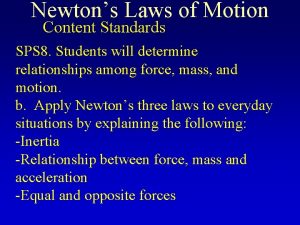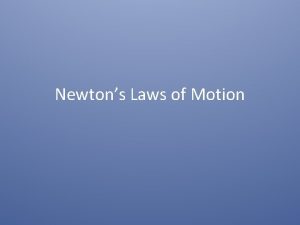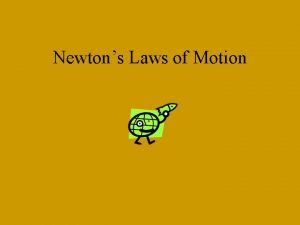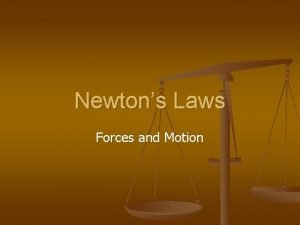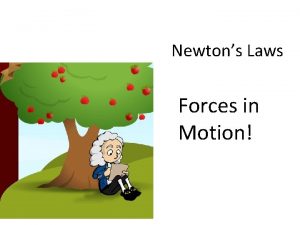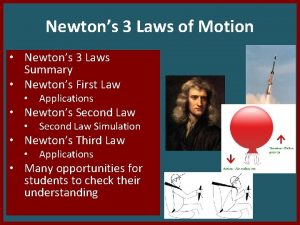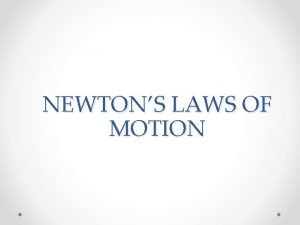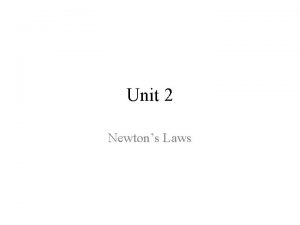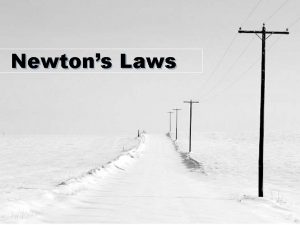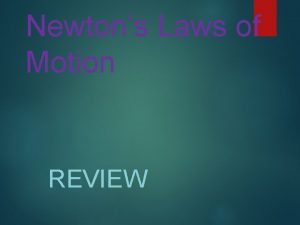FORCES NEWTONS LAWS OF MOTION Forces A force


















- Slides: 18

FORCES & NEWTON’S LAWS OF MOTION

Forces A force can be defined in numerous ways. However, the simplest would be a push or pull on an object. The unit is the Newton (N). A force is a vector quantity, which means it has a direction. You need to memorize one important conversion: 1 lb = 4. 448 N Examples of Forces: Hitting a ball, pulling a box, Weight of an object Non-Examples: Heat, Light, Mass, Temperature

Fundamental Forces There are four fundamental interactions/forces in the universe: These are forces that act over distances without touching one another. They are considered Field Forces do not need a medium to travel through.

Gravitational Force Any object with a mass has a gravitational field and will attract any other object with mass. This is done through the distortion of space. Weight is a measurement of the force of gravity on a mass. Symbol = Fg What is your weight? m = mass kg g = 9. 81 m/s 2

Electromagnetic Force This rises from the interaction of charged particles. It is responsible for holding electrons to nuclei and molecules together Charged particles include the proton and electron

Strong Force These forces arise from the interaction of gluons. (Theoretically) This force holds together the protons and neutrons in a nucleus of an atom and the quarks within the protons and neutrons.

Weak Force This force works over small distance and helps to keep the nucleus of atoms together. This force also mediates the nuclear decay of neutrons and protons.

Strength Order of Forces Strongest Strong Force 2. Electromagnetic Force 3. Weak Force 4. Gravitational Force 1. Weakest

Contact forces These are really specific electromagnetic forces in nature These are forces that arise during physical contact between objects. The two main contact Forces that we will talk about are the Normal Force (FN) and Friction (Fμ)

Normal Force A contact force that exists when two objects are pressed together and always acts perpendicular to the surface of the contact. Symbol: FN FN=mgcosθ

Friction Force This force opposes the displace of an object (matter) as it moves across the surface of another object. The amount of Friction depends of the shape of the surface.

Types of Friction Static Friction – the force that resists the initiation of sliding motion between two surfaces that are in contact and at rest. (Fs) ○ Equal and opposite forces are present until object moves ○ Fs, max – the amount of static friction force at the moment right before motion occurs Kinetic Friction – the force that opposes the movement of two surfaces that are in contact AND sliding over each other. (FK)

Forces on Ropes or Strings Tension - the force exerted by a string, rope or chain This is a contact force The Force of the rope is equal to the force exerted by the object the rope is attached to.

Newton’s Laws of Motion Newton’s First Law of Motion (Law of Inertia) An object will continue its motion until it is acted upon by an outside force. In other words an object has a tendency to keep doing whatever it is presently doing. This is called its’ INERTIA. The greater the mass of an object, the greater its inertia.

Newton’s Laws of Motion (2) Newton’s Second Law of Motion The acceleration of an object is directly proportional to the NET external force acting on the object and inversely proportional to its mass. Acceleration = Net Force Mass

Newton’s Laws of Motion (3) Newton’s Third Law of Motion If two bodies interact the magnitude of the force exerted on object 1 by object 2 is equal to the magnitude of force simultaneously exerted on object 2 by object 1. In other words, for every action, there is an equal and opposite reaction. These are called Action-Reaction Pairs. Forces will always come in pairs. Remember that action-reaction pairs DO NOT result in equilibrium because they act on OPPOSITE objects.

Force Analysis Free-Body Diagrams Forces are vector quantities. When analyzing different scenarios it is common practice to draw a FREE-BODY DIAGRAM. This helps an individual visualize what and how the forces are acting on the object. When you are drawing a free-body diagram you should: 1. Draw picture. 2. Identify forces acting on object 3. Place forces on picture.

Translational Equilibrium When analyzing different scenarios you must first decide if the object is in equilibrium. An object is said to be in translational equilibrium when there is no net force on an object. How can you tell: If it has a constant velocity (Not accelerating) it IS in equilibrium. Otherwise it is NOT in equilibrium.
 Newtons laws od motion
Newtons laws od motion Newtons third lw
Newtons third lw Law of newton 3
Law of newton 3 Newton's laws 3
Newton's laws 3 Derek leaves his physics book on top of a drafting table
Derek leaves his physics book on top of a drafting table Newton's law
Newton's law Fg physics formula
Fg physics formula Newton's 3 law
Newton's 3 law Newtons laws of gravity
Newtons laws of gravity Section 3 using newton's laws
Section 3 using newton's laws Section 3 using newtons laws
Section 3 using newtons laws Abcd8n
Abcd8n Newton's st law
Newton's st law Newtons law quiz
Newtons law quiz Newtons laws definitions
Newtons laws definitions Newtons 3 laws
Newtons 3 laws What is the newton's law
What is the newton's law Newton first law
Newton first law Example of law of inertia
Example of law of inertia




